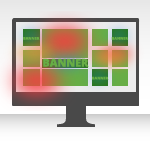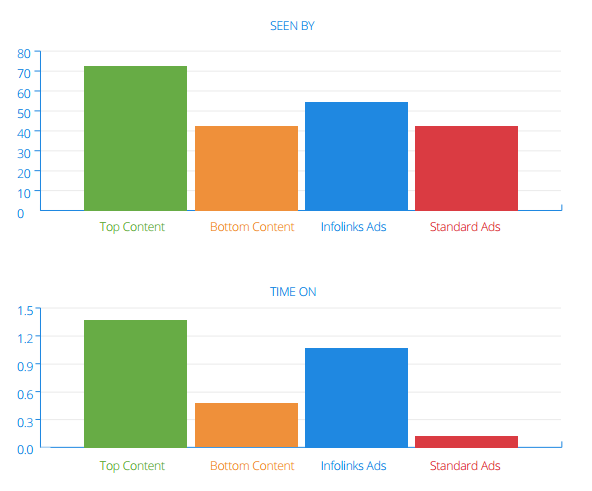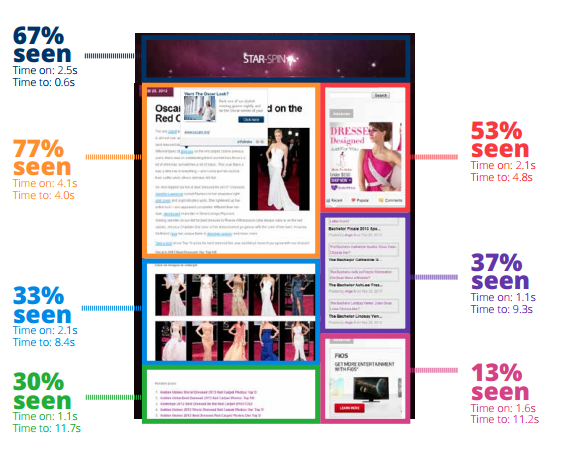 We are all painfully aware of the sub -.1percent clickthrough rates that have raised alarms throughout the industry over the last several years. DG MediaMind puts the average banner ad response rate at an appalling .1 percent. Looking at that from the flipside, 99.9% of banner ads generate no measurable engagement. Our industry is putting in an awful lot of work for a 99.9% failure rate, wouldn’t you agree?
We are all painfully aware of the sub -.1percent clickthrough rates that have raised alarms throughout the industry over the last several years. DG MediaMind puts the average banner ad response rate at an appalling .1 percent. Looking at that from the flipside, 99.9% of banner ads generate no measurable engagement. Our industry is putting in an awful lot of work for a 99.9% failure rate, wouldn’t you agree?
We here at Infolinks are always focused on improving digital advertising and studying consumer banner blindness. That’s why we, in partnership with market research company EyeTrackShop, conducted an extensive study, aimed at examining the issues of ad location, responsiveness and brand recall, to provide specific direction for how the digital media industry can tackle the detrimental problem of banner blindness.
“The simple fact is, display as we know it is broken,” says Infolinks CEO Dave Zinman. “Many in the industry have turned a blind eye to the issue. We analyzed the eye movements of online users in order to understand their reactions to ads and content at a fundamental level. These findings point to fixes the industry can easily employ today. What are we waiting for?”
Banner Blindness Study Conclusions and Insights:
Location, Location, Location
156% more people saw the top content area of the page versus the bottom content area of the page, indicating that the area above the fold is significantly more visible than the areas below. While (obviously) organic content will always be more visible than ads, ads placed in the right locations can be much more visible than marginal content areas and traditional ad placements.
Go Native
The eye tracking examination showed that natively integrated Infolinks ad units were seen 47% quicker than banner ads on the same pages, and that the area on the page containing these units was seen by 451% more people than the banner ad. Furthermore, the study also found that the time spent in those content areas was 4000% more than the time spent in the area containing the banner ad, resulting in significantly higher brand recall.
Be Visible & Relevant:
The unique placement of Infolinks InSearch ad units managed to beat banner blindness by being both unobtrusive and attention-grabbing, according to 75% of study respondents who stated that the InSearch ads were easier to notice in this format. The unconventionality of the placement in the margins served to attract attention—the time to these units was 50% quicker than the time to the standard display units on the page. And because the units in the margins were contextually targeted to the content of the page in question, time spent on these units was 25% greater.
The Solutions to Banner Blindness:
Placement Matters:
Eye tracking shows that consumers tend to see more content at the top of the page but often skim past leaderboard and skyscraper ad units, presumably because they have learned from experience that those areas usually contain ads rather than content, and that those ads typically do not relate to their current task. Simply put, users have trained their eyes to automatically avoid looking at those standard placements. Placement “above the fold” does offer the best visibility; however, engagement is not simply about location.
Relevance Matters:
As the positive performance of the ads with real-time relevance against standard banners proves, consumers are more likely to engage with an ad if it provides a useful service – such as helping them find a product they were searching for, or driving them to additional pages for more information on a topic they were reading about. 66% of respondents said that the InSearch ad employing real-time intent targeting was helpful in supporting their search efforts.
Experience Matters:
Study respondents across the board were much more likely to notice, engage with and remember the non-traditional placements over standard banner ads. This is because the ad units were designed with the user experience in mind. They were designed to be subtle and useful, to enhance content rather than disrupt it, to engage rather than bombard – that is how you fight banner blindness.
According to Infolinks CEO, Dave Zinman, “This study confirms the ideals upon which we have built our business — that advertising should be about enhancing the user experience. This study makes it clear that ads that break out of the rut of traditional placement and are rooted in user intent can combat banner blindness and reverse declining consumer engagement.”
Want to learn more about Banner Blindness and to stay up to date with everything new in the digital marketing world? Be sure to follow Infolinks on Facebook, Twitter and Google+ and also visit our blog for all the latest!




